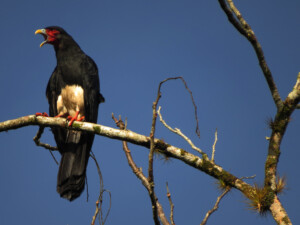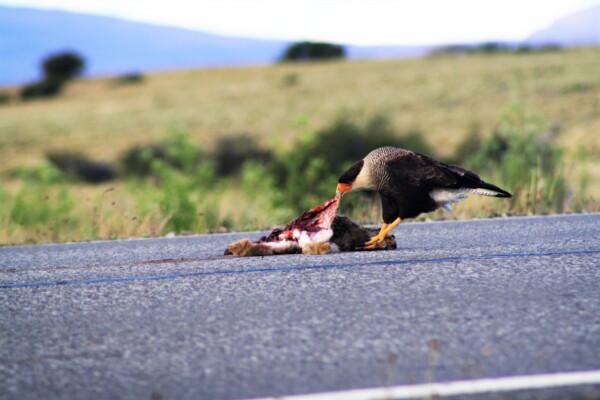
LINKED PAPER
Assessing Knowledge Gaps of the Caracaras: Identifying Knowledge Gaps, and Recommendations for Future Research. Morrison, J.L., Saggese, M.D. 2024. Journal of Raptor Research. DOI: 10.3356/JRR-23-39 VIEW
Caracaras are an inquisitive, gregarious, highly intelligent group of predatory birds in the falcon family, whose quirks go largely unnoticed by the public. Caracara researchers, however, say it’s time for that to change. A recent literature review has revealed alarmingly large knowledge gaps in the field of caracara research. Several species have hardly been studied at all. While caracaras are generally listed as species of Least Concern, this may be inaccurate given the lack of completed research on their population trends and basic life histories. Caracara researchers are calling all colleagues to rectify these gaps at a time when new technology is increasing research possibilities, and several caracara species are expanding their ranges into more urban centers.

Figure 1. Crested Caracara Caracara plancus scavenging on roadkill along a highway near Calafate, Santa Cruz province, Argentina © Miguel Saggese.
Caracaras live exclusively in the Americas. Of the nine living species, only the Crested Caracara (Caracara plancus) reaches the United States. The rest range throughout parts of Central and South America, where they fill the niche usually held by crows and ravens in North America. Caracaras are scrappy, plotting, and adaptable. They are scavengers, and therefore suffer from an arguably undeserved negative reputation, which results in human persecution and likely limits them from appearing in conservation discourse.
To establish an understanding of caracara research to date, Morrison and Saggese conducted a thorough literature review on all the research published on caracaras between 1900 and 2022. They categorized their findings by research topic and species, offering a revised picture of what we know (and don’t know), about these birds. The species most studied were those with broad ranges and significant overlap with humans, such as the Crested and Chimango (Milvago chimango) Caracaras. In fact, 82% of the sources identified focused on the Crested Caracara. The least studied species were the forest-dwelling Black Caracara (Daptrius ater) and Red-throated Caracara (Ibycter americanus). Argentina, Brazil, Chile, and the U.S. have conducted most of the studies on caracaras thus far. Overall, foundational gaps still exist on basic life history information for many species, even though the tools exist to conduct such projects. It is the interest and funding that are lacking.

Figure 2. Nestling Crested Caracaras Caracara plancus in southern Patagonia, Santa Cruz province, Argentina. There this species nest in native shrubs, exotic trees and human-made structures © Miguel Saggese.
These findings are important because caracaras face a disproportionately high number of threats compared with other birds due to their life history, ecology, and reputation. Dangers include entanglement, poisoning, leg-hold traps, and unfortunately, direct human persecution. As top predators and scavengers, caracaras are agents of prey regulation and biomass removal, which are important ecosystem services. Recent population crashes of Old World vultures made it undeniably clear that without vultures, rotting flesh and disease remain on the landscape for longer periods of time, which impacts both human and ecosystem health. Little was known about vultures at the time of these crashes. Few were interested in them. Sound familiar?
The Old World vulture crashes demonstrate the importance of scavengers, and the unpredictable danger of knowledge gaps. Morrison and Saggese encourage collaboration between vulture and caracara biologists to bolster collective knowledge and prevent similar consequences from occurring in the Americas. Morrison says, “if we have a similar message, that these birds are interesting, we can work towards eliminating the persecution and negative reputation,” and she says now is the time for increased research efforts. “There are new advances in technology making research on rare and remote species more possible. There has simply not been enough attention given to this group and we argue there should be.”
Saggese points out that ignorance has already led to the disappearance of one caracara species, and as such, “we need to start looking at them as a group.” The Guadalupe Caracara (Caracara lutosa), endemic to Guadalupe Island, was intentionally eradicated by goat herders in the 1890s. Limited understanding and misperceptions often result in such undeserved hostility towards scavengers, something that more research can help prevent. Human-caracara conflicts (both real and perceived) are likely to increase given their expansion into areas inhabited by humans, so understanding the causal effects of these interactions is a timely priority.
Moving forward, Morrison and Saggese recommend additional research on basic natural history, foraging ecology, and evolutionary biology — specifically on the evolution of cognition in caracaras given their puzzle-solving abilities and use of play to investigate novel objects. Caracaras are ideal research subjects: brazen, social, easily intrigued, and big enough to fit with GPS transmitters. For up-and-coming conservation biologists, caracaras offer an untapped realm of research innovation, and an opportunity to aid in conserving a fascinating group of birds. As Saggese reminds us, “we cannot conserve what we don’t know.”
For more information on how to get involved with the Caracara Working Group, contact either author.
Image credits
Top right: An adult Red-throated Caracara Ibycter americanus vocalizing and perching on a branch of a tree in the Upala’s (Alajuela province) rain forest of Costa Rica © Pablo Camacho.
Blog posts express the views of the individual author(s) and not those of the BOU.
If you want to write about your research in #theBOUblog, then please see here





